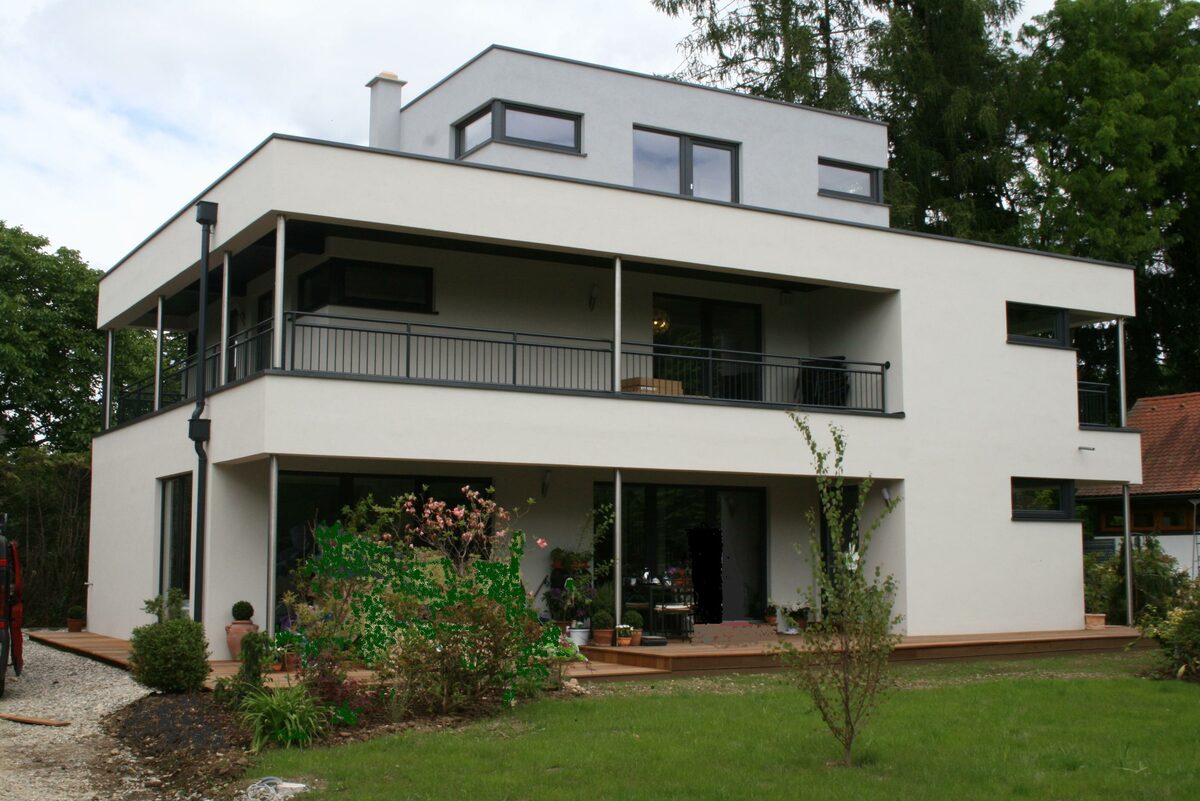CLT Construction
Cross laminated timber - a new age building material for commercial construction and residential projects
Developed in Germany and Austria in the early 1990s, Cross-Laminated Timber or CLT is a construction material that's becoming increasingly valued among architects, builders and property developers alike. It is a subtype of engineered wood panelling, made of layers of solid-sawn lumber glued together, that's been widely used for the construction of both public and private buildings. Due to its versatility and reliability, as well as its eco-friendly nature, CLT is steadily growing as one of the preferred construction materials for load-bearing structures, as well as interior and exterior visual structures of modern, sustainable buildings.

Why CLT Construction
SUSTAINABILITY
CLT building materials allow for a sustainable way of construction, which is one of their greatest advantages. Since the manufacturing process of CLT panels effectively utilises timber, it considerably reduces the amount of waste created during it. In addition to that, it creates a significantly smaller amount of greenhouse gas emissions than concrete or steel production. Therefore, using CLT is a green and eco-friendly way to build that reduces the carbon footprint of the construction process.
CLT building materials allow for a sustainable way of construction, which is one of their greatest advantages. Since the manufacturing process of CLT panels effectively utilises timber, it considerably reduces the amount of waste created during it. In addition to that, it creates a significantly smaller amount of greenhouse gas emissions than concrete or steel production. Therefore, using CLT is a green and eco-friendly way to build that reduces the carbon footprint of the construction process.


DESIGN FLEXIBILITY
CLT building materials can be used for various purposes, such as building roofs, walls or ceilings. Depending on the final product, the thickness of CLT can be increased at will by adding or removing layers of wood. Moreover, CLT building materials can be combined with other materials used for construction, like glulam beams that can add further flexibility when it comes to style, architectural finish and design.
CLT building materials can be used for various purposes, such as building roofs, walls or ceilings. Depending on the final product, the thickness of CLT can be increased at will by adding or removing layers of wood. Moreover, CLT building materials can be combined with other materials used for construction, like glulam beams that can add further flexibility when it comes to style, architectural finish and design.
THERMAL INSULATION
Buildings made of CLT have naturally high thermal insulation since they are made using planks of wood glued together. Thanks to that, using it as a construction material helps to save on future maintenance costs of the building. It is also important to mention that, with the right planning, CLT building materials allow to build a structure free of thermal bridges, radically minimizing heat loss.
Buildings made of CLT have naturally high thermal insulation since they are made using planks of wood glued together. Thanks to that, using it as a construction material helps to save on future maintenance costs of the building. It is also important to mention that, with the right planning, CLT building materials allow to build a structure free of thermal bridges, radically minimizing heat loss.


COST-EFFECTIVENESS
Cross-laminated timber construction materials are considered cost-effective for several reasons. For example, using CLT reduces foundational costs as it is a lighter material than steel or concrete. And the fact that most CLT panels can be prefabricated, then later assembled together on the construction site, greatly reduces on-site building time, which is an important factor in the total costs of the project.
Cross-laminated timber construction materials are considered cost-effective for several reasons. For example, using CLT reduces foundational costs as it is a lighter material than steel or concrete. And the fact that most CLT panels can be prefabricated, then later assembled together on the construction site, greatly reduces on-site building time, which is an important factor in the total costs of the project.
COST-EFFECTIVENESS
Cross-laminated timber construction materials are considered cost-effective for several reasons. For example, using CLT reduces foundational costs as it is a lighter material than steel or concrete. And the fact that most CLT panels can be prefabricated, then later assembled together on the construction site, greatly reduces on-site building time, which is an important factor in the total costs of the project.
Cross-laminated timber construction materials are considered cost-effective for several reasons. For example, using CLT reduces foundational costs as it is a lighter material than steel or concrete. And the fact that most CLT panels can be prefabricated, then later assembled together on the construction site, greatly reduces on-site building time, which is an important factor in the total costs of the project.

CLT Building Materials
CLT PRODUCTION
CLT Building materials are durable and often provide more strength and hardiness than other forms of hardwood. A cross-laminated timber construction panel usually consists of three, five or seven layers of kiln-dried timber. The layers are placed perpendicular to one another and then glued together in a press. The mechanical properties of cross-laminated timber are less variable than they are for other forms of hardwood and it is also more stable, providing a sturdy structure.
As the CLT panels are cut to the right shape and size by a machine from 3D technical drawings, all the window and door openings, as well as any other necessary design features can be created in a factory environment. Moreover, the use of computer-controlled machines ensures increased precision, minimizing the possibility of defects.
Due to the fact that the manufacturing process of CLT is sustainable and eco-friendly, the same can also be said about buildings created using this material. When extracted from sustainably managed forests, wood is one of the only renewable construction materials. Additionally, it has a much lower carbon footprint than other materials, as its production is not dependent on using fossil fuels. Therefore, using cross-laminated timber construction materials, builders can reduce their carbon footprint and create sustainable buildings, while also reducing overall construction costs and increasing project completion times.
CLT Building materials are durable and often provide more strength and hardiness than other forms of hardwood. A cross-laminated timber construction panel usually consists of three, five or seven layers of kiln-dried timber. The layers are placed perpendicular to one another and then glued together in a press. The mechanical properties of cross-laminated timber are less variable than they are for other forms of hardwood and it is also more stable, providing a sturdy structure.
As the CLT panels are cut to the right shape and size by a machine from 3D technical drawings, all the window and door openings, as well as any other necessary design features can be created in a factory environment. Moreover, the use of computer-controlled machines ensures increased precision, minimizing the possibility of defects.
Due to the fact that the manufacturing process of CLT is sustainable and eco-friendly, the same can also be said about buildings created using this material. When extracted from sustainably managed forests, wood is one of the only renewable construction materials. Additionally, it has a much lower carbon footprint than other materials, as its production is not dependent on using fossil fuels. Therefore, using cross-laminated timber construction materials, builders can reduce their carbon footprint and create sustainable buildings, while also reducing overall construction costs and increasing project completion times.
CLT PROPERTIES
CLT panels are widely used for the production of structural elements, as well as interior and exterior visual structures that can be used for almost any type of building. When applied indoors, CLT building materials require no additional coatings - it is tough as is and has an attractive finish that makes it a desirable and sustainable finishing material. Meanwhile, when it is used for the external facade, additional protection against the effects of weather must be applied. At the least, it should be coated with mineral paint every 5 years, however, the most efficient and also the most popular option is to cover it with protective cladding.
CLT building materials are more fire-resistant than untreated steel or other construction materials. In case of a fire, the outer layers of CLT structures burn first and turn to char, which prevents further damage to it by containing the fire for 30 to 120 minutes. CLT buildings can also be built to be completely airtight, which won't allow smoke to pass from one room to another in the case of a fire, providing increased fire safety.
Airtightness also plays an important role in the energy efficiency of a building, decreasing the level of its thermal conductivity. Therefore, CLT building materials can help achieve high thermal efficiency, allowing to save on future building maintenance costs. In fact, interior temperatures in buildings made using CLT have the potential to be controlled using nearly one-third of the energy required to heat or cool an average house.
CLT panels are widely used for the production of structural elements, as well as interior and exterior visual structures that can be used for almost any type of building. When applied indoors, CLT building materials require no additional coatings - it is tough as is and has an attractive finish that makes it a desirable and sustainable finishing material. Meanwhile, when it is used for the external facade, additional protection against the effects of weather must be applied. At the least, it should be coated with mineral paint every 5 years, however, the most efficient and also the most popular option is to cover it with protective cladding.
CLT building materials are more fire-resistant than untreated steel or other construction materials. In case of a fire, the outer layers of CLT structures burn first and turn to char, which prevents further damage to it by containing the fire for 30 to 120 minutes. CLT buildings can also be built to be completely airtight, which won't allow smoke to pass from one room to another in the case of a fire, providing increased fire safety.
Airtightness also plays an important role in the energy efficiency of a building, decreasing the level of its thermal conductivity. Therefore, CLT building materials can help achieve high thermal efficiency, allowing to save on future building maintenance costs. In fact, interior temperatures in buildings made using CLT have the potential to be controlled using nearly one-third of the energy required to heat or cool an average house.
CLT Construction Details off-site
One of the greatest advantages of CLT building materials is the fact that they offer the possibility to assemble and fully manufacture large structures off-site before they reach the construction site. The versatility of cross-laminated timber allows prefabricating building parts in various ways. Depending on the details of the construction project, CLT can be either used to make wall, roof, stair and floor panels that are later assembled on-site or even for large-scale modules that are delivered to the construction site in an already assembled form. In either case, the prefabricated CLT elements are compact and easy to transport, making it possible to deliver them even across large distances.
Cross Laminated Timber Construction on-site
A large part of cross-laminated timber construction can be taken care of in the factory, which makes it easier for builders to install everything on-site as quickly as possible. The prefabricated panels or modules can be swiftly installed and often require fewer deliveries and smaller on-site crews. It also means that the whole process can move forward at a greater speed, which helps decrease construction time and can even have the potential to lower the overall project costs, making the construction process more profitable to property developers.
Crucially, CLT building materials can also be easily used alongside other materials, as necessary to achieve the planned design or technical objectives of the project. And there are no specific restrictions for the foundation or roofing – concrete, steel or any other appropriate material can be used for that. Thanks to that, cross-laminated timber is becoming an increasingly popular material among construction companies across the world.
Crucially, CLT building materials can also be easily used alongside other materials, as necessary to achieve the planned design or technical objectives of the project. And there are no specific restrictions for the foundation or roofing – concrete, steel or any other appropriate material can be used for that. Thanks to that, cross-laminated timber is becoming an increasingly popular material among construction companies across the world.
Interested in further information about CLT construction?
Contact us to receive advice from our experienced CLT experts!
